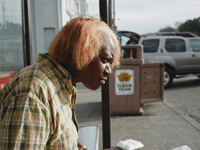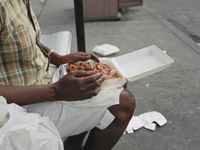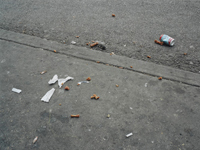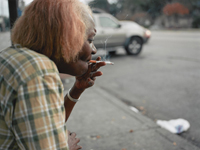Back in the olden days, philosophers thought a lot about water. Thales (sometimes considered the first philosopher) went out on a limb and proclaimed that “all is water.” This was a gutsy move given the fact that a simple walk around the block will convince most human beings that all is, in fact, not water. But Thales was after something more profound. He was trying to make a distinction between the “really real” and the way things seem, the way things appear. Water is the foundation, he was saying, water is what its all about. Such a distinction pretty much defined the act of philosophizing from then on.
The next guy to make a big claim about water was Heraclitus. He mentioned, notoriously, that you can’t step into the same river twice. For Heraclitus, all was not water. All was, instead, conflict, tension, movement, dynamism. The reason you can’t step into the same river twice is because the damn thing changes as part of its nature, its nature is to become different all the time. This led Plato to quip that if the nature of things is so unstable as that, you can’t even step in the same river once.
Ever since those early days of the water wars human beings have been trying to figure out what makes one thing one thing and another thing another thing. In very general terms, there have always been some people who are more comfortable with Being and some people who are more comfortable with Becoming. The Being people get excited about how identity remains stable, how a chair is always a chair, a table always a table. The Becoming people are fascinated by the gray areas, the things you can’t quite categorize, the fleeting, the indefinite.
Photography, since its invention in the 19th century, has always played the role of a double agent. On one hand, photography fixes time, a notoriously shifty and ever-changing phenomenon. But photography grabs time and sits it down. You could say that photography freezes moments of essence. This pleases the Being people. A photograph has a sliver of forever inside it.
But photography plays the other side of the field as well. That’s because photography is in league with the ephemeral. Photography loves the mundane, the seemingly inconsequential. Especially as the technology got simpler to use, photography became the great art of the passing moment. The snapshot is the friend of the Becoming people. Nothing pleases the Becoming folk more than a photograph of an inessential moment, an occurrence that just as well could have been otherwise and it wouldn’t matter all that much in the greater scope of things.
This brings us back to the old water problem. The photographer Paul Graham, in his current show at the Museum of Modern Art, “a shimmer of possibility,” is quoted as saying:
Perhaps instead of standing at the river’s edge scooping out water, it’s better to be in the current itself, to watch how the river comes up to you, flows smoothly around your presence, and reforms on the other side like you were never there.
 |
 |
 |
 |
| Paul Graham. New Orleans (Woman Eating), 2004. Four of six pigmented inkjet prints. © Paul Graham. |
Basically, this cheeky bastard wants his Being and Becoming, too. But he kind of achieves it. His trick is the series of photographs, the semi-narrative. The old saying tells us that a picture is worth a thousand words. Graham, however, thinks you need somewhere between four and nine pictures. Witness, for instance, the woman eating some less-than-appetizing-looking chicken in a parking lot. We see the woman in one shot. Then we get a shot of the chicken. Then we get the remnants of her meal on the pavement in the form of discarded napkins and such. Graham shoots the spectacular event with studied matter of factness, which is clearly the point. He’s sitting in the river of daily life, grabbing moments as they float by.
And it wouldn’t work with solo shots. He needs the four to nine images. This brings up an intriguing and possibly profound idea, which is that you need at least four moments to have an experience. Anything less is incomplete. But with four, you’ve got something, minimal completeness. On the other end, anything more than nine gets too complicated, moves from an experience to experiences. That’s the big thought, the Being thought.
The Becoming thought is in the content. Graham gravitates to the margins of the urban experience, which he redefines as the heart of experience. He isn’t shy of parking lots or suburbs, the daily scenes of life being lived in moments that are utterly without greater significance. It is close to pure immediacy. It works because Graham refuses to romanticize the everyday. He tries to take it truly as it is, the complete flatness of occurrences that do not matter.
My favorite series is of a man mowing an unremarkable patch of grass in a boring part of town. We get a few shots of him at various spots of the grass. He’s just working. Getting the job done. There’s a picture of a van parked in a space just off the grass. In short, we get the whole scene, the drama of it, which is the opposite of drama. The photos bring to mind Hemingway’s greatest contribution to the art of the short story. It clocks in at six words, “For sale: baby shoes, never worn.” There’s a similar economy to Graham’s work with one crucial exception. Graham trims Hemingway down even further, to precisely three words, “For sale: shoes.” That’s a pretty good story, too. It tells an uncomfortable truth, which is that most of the time spent living a life isn’t worth the effort of trying to recount it.
There is one shot in the man mowing series where Graham almost ruins it. The day was cloudy with patches of sun. As the man mows the grass it starts to rain in that special the-sun-is-out-but-it-is-raining way. This could be the epic moment, the something memorable actually happened moment. But Graham manages to tame it, to flatten the sunny rain back out and cleanse it of its mock-heroism. First of all he captures the mower as indifferent to the moment. He just keeps mowing. Secondly, Graham resists the temptation of the beautiful. There’s no glint, no sparkle. We see a few drops of rain as little smears coming down the photograph. We see rain as it is, bits of water in downward progress from the sky to the ground.
That is something. Graham stands in the middle of the river and reveals it as a flowing that does not matter, which is a realization that matters. • 3 April 2009




